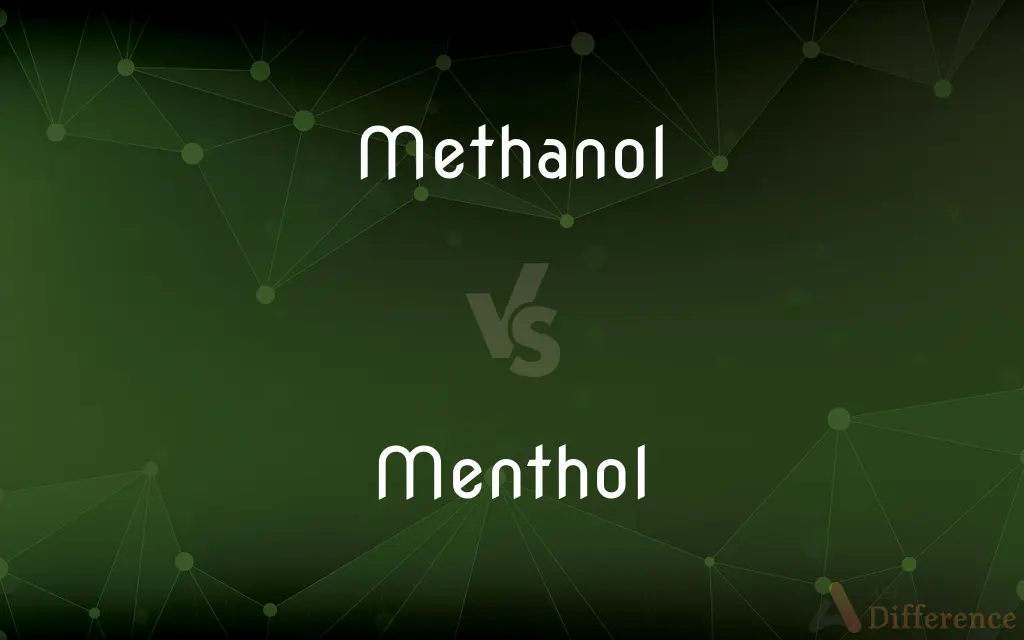Methanol vs. Menthol — What's the Difference?
Edited by Tayyaba Rehman — By Urooj Arif — Updated on March 9, 2024
Methanol is a simple alcohol used as a solvent and fuel, while Menthol is an organic compound providing a cooling sensation in products.

Difference Between Methanol and Menthol
Table of Contents
ADVERTISEMENT
Key Differences
Methanol, also known as wood alcohol, is a chemical compound with applications in industries as a solvent, antifreeze, and fuel. Its chemical structure enables it to dissolve a wide range of substances, making it invaluable in manufacturing and scientific research. Menthol, on the other hand, is derived from mint oils or synthesized and is known for its cooling and analgesic properties. It is widely used in medical and cosmetic products to provide relief and a refreshing sensation.
While methanol is a colorless, volatile liquid with a distinct smell, menthol is a crystalline solid at room temperature, with a characteristic minty aroma. This physical state difference affects their handling and application in various products and industries. Methanol's toxicity makes it dangerous for human consumption, leading to serious health risks if ingested. Conversely, menthol is generally regarded as safe for use in food and topical products, where it provides a cooling sensation without toxic effects.
The production of methanol primarily involves the catalytic hydrogenation of carbon monoxide, a process that requires specific conditions and catalysts. Menthol can be naturally extracted from mint plants or synthesized through various chemical processes, offering flexibility in sourcing and production methods. This difference highlights the contrast between methanol's synthetic, industrial focus and menthol's natural, consumer-oriented applications.
In terms of usage, methanol is crucial in the production of formaldehyde, plastics, and other chemicals, showcasing its role in industrial and manufacturing sectors. Menthol's applications are predominantly in personal care products, pharmaceuticals, and food, emphasizing its role in enhancing consumer experiences through flavor and sensory effects.
The environmental impact of methanol and menthol also diverges. Methanol's production and use in fuel can contribute to air pollution and greenhouse gas emissions, whereas menthol, especially when naturally sourced, has a lesser environmental footprint, aligning with sustainable and eco-friendly practices.
ADVERTISEMENT
Comparison Chart
Type
Simple alcohol
Organic compound
Primary Use
Solvent, antifreeze, fuel
Cooling sensation, flavoring in products
State at Room Temperature
Liquid
Solid
Toxicity
Highly toxic, not safe for consumption
Generally safe for topical application and ingestion in small amounts
Production
Catalytic hydrogenation of carbon monoxide
Extracted from mint oils or synthesized
Applications
Industrial solvents, antifreeze, fuel additives
Personal care, pharmaceuticals, food flavoring
Environmental Impact
Can contribute to pollution and greenhouse gas emissions
Lesser environmental footprint when naturally sourced
Compare with Definitions
Methanol
A volatile, colorless liquid used as a solvent and fuel.
Methanol is used as a feedstock in the production of chemicals.
Menthol
A crystalline substance with a cooling effect, derived from mint.
Menthol is used in cough drops for its soothing properties.
Methanol
Highly toxic and dangerous if ingested.
Accidental consumption of methanol can lead to severe poisoning.
Menthol
Predominantly used in personal care and pharmaceuticals.
Topical creams for muscle pain often contain menthol.
Methanol
Utilized as an antifreeze in automotive industries.
Methanol is added to windshield washer fluid to prevent freezing.
Menthol
Safe for consumption and use in topical products.
Chewing gum contains menthol for a refreshing taste.
Methanol
Produced mainly from the hydrogenation of carbon monoxide.
Methanol plants use catalysts to convert syngas to methanol.
Menthol
Adds flavor and fragrance to food and cosmetics.
Menthol is a popular additive in toothpaste for a fresh sensation.
Methanol
Known for its wide application in industrial processes.
Methanol is essential in creating formaldehyde and plastics.
Menthol
Can be naturally extracted or chemically synthesized.
Natural menthol is obtained from peppermint oil.
Methanol
Methanol, also known as methyl alcohol amongst other names, is a chemical and the simplest alcohol, with the formula CH3OH (a methyl group linked to a hydroxyl group, often abbreviated MeOH). It is a light, volatile, colourless, flammable liquid with a distinctive alcoholic odour similar to that of ethanol (potable alcohol).
Menthol
A crystalline alcohol with a minty taste and odour, found in peppermint and other natural oils. It is used as a flavouring and in decongestants and analgesics.
Methanol
A toxic, colourless, volatile flammable liquid alcohol, made chiefly by oxidizing methane.
Menthol
Menthol is an organic compound made synthetically or obtained from the oils of corn mint, peppermint, or other mints. It is a waxy, crystalline substance, clear or white in color, which is solid at room temperature and melts slightly above.
Methanol
A colorless, toxic, flammable liquid, CH3OH, used as an antifreeze, a general solvent, a fuel, and a denaturant for ethyl alcohol. Also called carbinol, methyl alcohol, wood alcohol, wood spirits.
Menthol
A fragrant white crystalline organic compound, C10H20O, obtained from peppermint oil or synthesized. It is used in perfumes, in cigarettes, as a mild topical anesthetic, and as a mint flavoring.
Methanol
(organic compound) The simplest aliphatic alcohol, CH3OH; a colourless, toxic, inflammable liquid, used as a solvent, antifreeze, in the chemical industry, and in the preparation of methylated spirit.
Menthol
(chemistry) a cyclic monoterpene alcohol; the major component of the essential oil of peppermint; used in pharmaceutical preparations as an antitussive and antipruritic agent, as a nasal decongestant, and in menthol cigarettes
Methanol
The simplest alcohol of the paraffin series, CH3.OH; methyl alcohol. Called also wood alcohol. It is used as an antifreeze solvent, as a fuel, and as a denaturant for ethyl alcohol.
Menthol
A menthol cigarette.
Methanol
A light volatile flammable poisonous liquid alcohol; used as an antifreeze and solvent and fuel and as a denaturant for ethyl alcohol
Menthol
A white, crystalline, aromatic substance (C10H20O) resembling camphor, extracted from oil of peppermint (Mentha); - called also mint camphor or peppermint camphor. It has the peculiar effect on skin and membranes of making them feel cool, and is used in liqueurs, confections, cigarettes, cough drops and perfumes, among other things.
Menthol
A lotion containing menthol which gives it a mint flavoring
Common Curiosities
Is methanol safe for human consumption?
No, methanol is highly toxic and dangerous if ingested, leading to serious health risks.
What differentiates the production processes of methanol and menthol?
Methanol is produced through the catalytic hydrogenation of carbon monoxide, while menthol is either extracted from mint oils or chemically synthesized.
How is menthol obtained?
Menthol can be naturally extracted from mint plants or synthesized through chemical processes.
What are the main uses of methanol and menthol?
Methanol is primarily used as a solvent, in antifreeze, and as fuel, whereas menthol is used for its cooling effect in personal care products and food flavoring.
How do the physical states of methanol and menthol at room temperature affect their application?
Methanol being a liquid and menthol a solid allows them to be suited for different applications; methanol in industrial processes and menthol in solid-form products like balms and creams.
What role does menthol play in pharmaceuticals?
Menthol is used for its analgesic and cooling properties, providing relief in products like cough drops and topical pain relievers.
Can methanol be used in personal care products?
Due to its toxicity, methanol is not safe for use in products intended for direct human consumption or topical application.
Are there any environmental concerns associated with methanol?
Yes, the production and use of methanol as fuel can contribute to air pollution and greenhouse gas emissions.
Can both methanol and menthol be found in food products?
Menthol may be used in food for flavoring, but methanol is not safe for consumption and is not used in food.
How does menthol create a cooling sensation?
Menthol activates cold-sensitive receptors in the skin, creating a cooling sensation without actual temperature change.
Is it possible to synthetically produce menthol?
Yes, menthol can be synthesized in the lab, allowing for a consistent supply for its various applications.
Can methanol be used as a renewable energy source?
Yes, methanol is considered a potential renewable fuel, especially when produced from biomass.
What are the symptoms of methanol poisoning?
Symptoms include headache, dizziness, nausea, and in severe cases, blindness and death.
How does the environmental impact of menthol compare to synthetic chemicals?
When naturally sourced, menthol has a lesser environmental footprint compared to many synthetic chemicals.
What precautions should be taken when handling methanol?
Proper safety equipment and ventilation are essential due to its volatility and toxicity.
Share Your Discovery

Previous Comparison
Interval vs. Ratio
Next Comparison
Assurance vs. ReassuranceAuthor Spotlight
Written by
Urooj ArifUrooj is a skilled content writer at Ask Difference, known for her exceptional ability to simplify complex topics into engaging and informative content. With a passion for research and a flair for clear, concise writing, she consistently delivers articles that resonate with our diverse audience.
Edited by
Tayyaba RehmanTayyaba Rehman is a distinguished writer, currently serving as a primary contributor to askdifference.com. As a researcher in semantics and etymology, Tayyaba's passion for the complexity of languages and their distinctions has found a perfect home on the platform. Tayyaba delves into the intricacies of language, distinguishing between commonly confused words and phrases, thereby providing clarity for readers worldwide.
















































